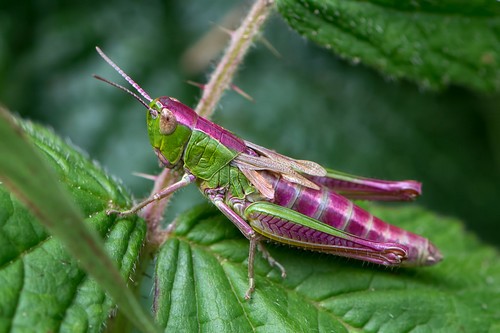Insects have always been hated and considered gross creatures by the human kind. They would rather see a ticking time bomb in their houses than a habitat of these creepy creatures.
Perhaps we haven’t yet learnt to appreciate their importance to nature and us. Insects are the rubbish collectors of the Earth who clean up mucky things like dung and dead bodies. In return they habitat our homes for food, warmth and shelter. So as an acknowledgement of their role in nature here are 10 facts that will make you visualize insects in an amusing way:
#1. Aromatic mating technique

The male Luna Moth’s feelers (antenna like organ) are long and feathery. It uses them to smell out female moths many kilometers away!
The Luna moth is a lime green, Nearctic Saturniid moth in the family Saturniidae. It is one of the largest moth species residing in North America. It exhibits a phenorome (it is a chemical released by animals) mating system. Determined and undeterred by obstacles, the male moths will persistently follow the scent left behind by the females (all males are the same!). Since the Luna moth is nocturnal, mating occurs only when there is no daylight.
#2. Listening with legs

Yes there are insects that hear stuff with their legs! The long-horned grasshopper has ears on both its front legs (its ears do not look like ours, of course). They are tiny holes with skin stretched over the top- a bit like miniature drums. These thin membranes vibrate even by the tiniest bits of sound.
These hair like antennae are longer in length than the body. The females have a sword shaped egg laying tubular structure and wing covers that differ in shape. They are primarily nocturnal in habit, with strident mating calls.
#3. Even insects show motherly love

The most startling fact about the female Earwig is that it shows parental instinct, a trait virtually unheard of in the insect world. Like all mothers (at least the human ones), a mother Earwig spends all winter looking after her eggs. She licks them clean and keeps the warm.
When they hatch, she feeds them with food brought up from her stomach (does not seem too appetizing!). Earwig nymphs molt about five times before reaching adult size. The mother takes care of her children until after their second molting.
#4. Insects with Armors

(No, it is not made of valyrian steel) Beetles have two pairs of wings, but they only use one pair to fly. The only functional wings are the hind wings. The front pair called elytra are rigid and not used for flying. It acts like a thick piece of armor, covering the beetle’s delicate wings and soft body.
The elytra have an intelligent structure with super hydrophobic characteristics (i.e. extremely difficult to wet). Their inner structure helps to provide light mass and high strength. When it wants to fly, the beetle opens its armor casing and stretches out its wings.
#5. Robbing the dead

Burying beetles have no respect for the dead! The males emit pheromones (sex attractants) to attract the females. They compete among themselves for the carcass, with size determining who claims the prize (unfair? Well they don’t think so). When they find a dead animal, they dig away the soil until the body sinks into the ground. Then they lay their eggs inside the body and cover it with soil. When the eggs hatch out, they feed on the dead (well-stocked meat store waiting for them!).
Burying beetles are nature’s most productive recyclers. But like other species, undue human intervention has meant a rapid decline of the burying beetles for almost a century now.
#6. Shooting enemies

Watch out for the bombardier beetle! As its name suggests, the bombardier beetle shoots its enemies with a jet of hot, stinging liquid. As the jet is fired, it makes a sharp cracking sound like a tiny gun going off (boom!).
The boiling, superheated spray is benzoquinone which is created by combining two chemicals in a protective chamber located in the backside of the beetle. The resultant chemical reaction boils the mixture, also creating the pressure required to ejaculate at the predator. The bombardier beetle’s advanced internal defense mechanism represents a remarkable illustration of natural evolution.
#7. Grasshoppers playing the violin

The meadow grasshopper plays its body like a violin. The sound is produced by rubbing the inner surface of the back leg against the edges of the forewing. The hind leg functions like a bow while the forewing acts as a taut string making a loud chirruping sound. On a warm summer day we may have a whole orchestra in our garden!
The meadow grasshopper or scientifically known Chorthippus parallelus is a common species of grasshoppers found in well vegetated areas of Europe and some parts of Asia. It is a member of the slant faced grasshopper group, which contain a number of species that stridulate.
#8. Bees carrying a brush and a comb!

Honey bees have little baskets on their back legs and brushes of hair on their other legs. When a bee lands on a flower, it brushes a powder called pollen into its baskets. Then it flies back to the hive to feed the pollen to its young. Bees not only have a brush, they have a comb too! It is present on their front legs, and they use it to clean their feelers.
Collecting nectar to make honey is hard work. They may collect pollen from as many as 500 flowers-in a single trip. Scientific research has shown that approximately 22,700 bees are required to fill a single jar of honey!
#9. Camping in a tent

Weaver ants sew leaves together to make tents for themselves, and they use their larvae as needles and thread! These nests are among the most complex ant nests. To create their nests, the ants pull the edges together by shortening the chain. Once the edges are in place, each ant holds a young grub in its mouth, and pokes it through the edges of two leaves. The grub makes a silky thread which stitches the two leaves firmly together (proves the value of team work!).
The ability of simple minded ants to co-ordinate on such complex tasks is being studied for applications in robotics. If the ant behavior could be better understood, simpler robots could be built to achieve highly complex tasks.
#10. Mosquitoes have more teeth than humans

They are not exactly teeth but they have 47 sharp edges on the tip of the proboscis which help in cutting through the skin. Proboscis are designed like a hollow needle attached to their mouth. Using these needles, mosquitoes are able to pierce our skin and extract the blood from it (like sipping out from a straw!).
Unlike human teeth, however, these sharp edges are not used to break down any food since their food- blood is already in the form of a liquid. Therefore, the pain we experience after a mosquito “bite” is not due to it sucking blood but instead the proboscis stabbing into us. Mosquito bites can be very dangerous. It can cause a dangerous disease called malaria. Over 200 million people catch malaria every year and more than a million die from it.
Written By: Debjyoti Samanta






